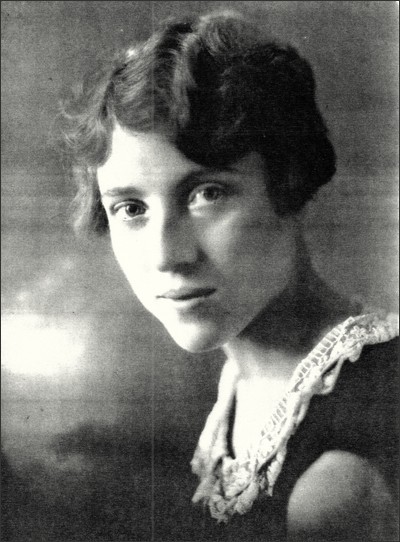 Helen Rousseau
Helen Rousseau
Helen Rousseau
(1896-1992)
Her Life and Her Paintings
By her daughter Shirley Rousseau Murphy
Part One: A Painter's Early Life
Rochester, Indiana, 1903
Snow climbs the town, hugs the village houses, decorates shop windows, lays scarves across heavy evergreens where two little girls cling to their sleds; small, light sleds tied secretly to a heavy sleigh hauling lumber. No one saw them hitch on. Twin girls wrapped in heavy coats, thick caps streaming long blond hair into the icy wind. Four sturdy bay horses pull uphill, icy street embossed with sleigh tracks and hoof-prints, marked by occasional auto tires, Six-year-old twins clinging, watching the world heave uphill, saving the pictures in their heads: Rolling gray skies. Snow clinging to black manes. Cloud patterns racing across snowdrifts, racing over white and tilting rooftops, Blowing shadows that will come alive again in pictures, alive later on paper. Always there are pictures.
Always have been pictures in their heads, since they could peer out of their crib, since they could sit at a little table exploring bright paint, laying on delicious colors.
The girls' hunger to make pictures puzzles Mama. She would understand music in their souls, would understand the clear, singing voices of her fledgling daughters. That would be as natural as breathing. But pictures?
Mama has always sung to them ever since they nursed, sung fairy tales, told the stories of operas, the arias rising in her rich voice, hoping the girls will grow up filled with music.
But the girls' heads are full only of pictures, full to bursting with color and with bold-flying shapes. Helen paints the life of Mama's fairytales with fierce excitement; as she grows older she covets the details of the town outside their windows, men working in the street, racing horses pulling fancy cabs, grazing cows hazed by barking dogs, rolling lines of plants stitching a hill where men farm and plow. So many pictures of the countryside when Papa takes them for a Sunday ride in a hired buggy. Papa, doesn't keep a horse. Hiring is more frugal. Some people say Papa is cheap but Fred Hoffman's family has plenty to eat, to dress themselves, to keep a warm house in these pre-depression days.
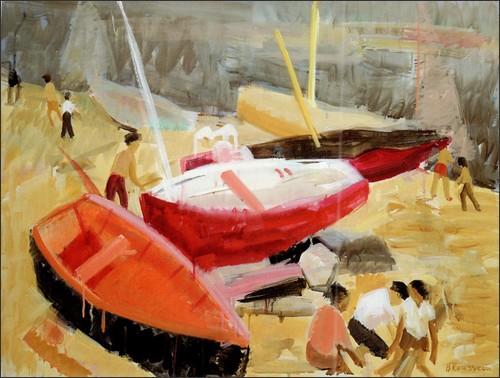 Red Boats (early 1950s)
Red Boats (early 1950s)
Papa is no taller than Mama, A short, square German man who emigrated to America at sixteen, escaping the killing and enslavement of the first world war. He began at once to do odd jobs, any work he could find. He put himself through college, studied geology and civil engineering until he had a real job designing tall concrete bridges, broad highways, heavy concrete dams--and then he married Mama. Papa always wears a three piece suit, starched white shirt and tie even when he's working in his garden. Papa loves making a garden, providing food for his family; that is his German nature. He is a hunter, as are many men in his day. He brings home venison and elk for their table, quail and pheasant. On holidays when all the cousins gather, the aroma of wild, roasting meat fills the house, Mama in her long blue apron. She is a dark-eyed Virginia beauty, Mama. Long black hair flowing or done up in a twist. She loves to cook, she makes southern dishes, makes fancy cookies too elegant to eat but too delicious to leave. She sings while she cooks, she sings even more beautifully in the church choir. A fine Southern woman, polite and proper, she doesn't always say what she's thinking. She likes nice furniture, nice things around her, Chinese vases, oriental rugs, dark and sleek carved tables. One would not think she is descended from rough-working pioneer women who could handle skillfully an ax and a rifle--Mama descended from Daniel Boone's family, in direct line from Daniel Boone's sister.
Mama's spirit filled with music doesn't have the girls' need to bring alive rolling skies, storm clouds as rich as song. Can't Mama see how color and shadow make their own glory. Mama doesn't think the girls' childhood paintings can compete with the thrill of any music--nor does she think her blond, green eyed twins are beautiful. To Mama, pale little Helen and Mabel seem unfinished. Not until their baby sister, black- haired, dark-eyed Ruth is born does Mama cuddle and spoil, does Mama show true delight in her new baby--the girls have never been spoiled. Mama loves them and takes good care of them, but now she delights extravagantly in dark-eyed Ruth; and the blond twins, all their lives, will know that hard little brush of resentment,
*
Still, Ruth is part of the family; soon their world settles in, the twins learn to tolerate and then to truly care for their little sister. They share their picture books with her so that soon Helen and Mabel learn to read, Iearn as swift and eager as they paint. When the two are old enough to cross the streets alone they spend hours in the newly opened Rochester library, shelves filled with dog-eared books that neighbors have donated.
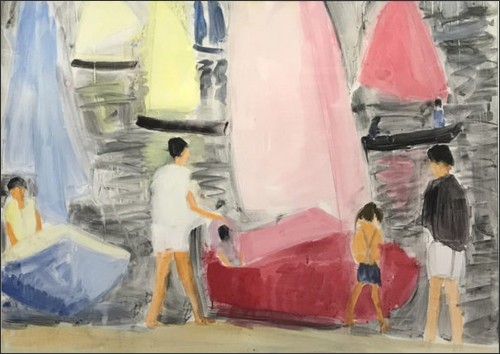 Pink Sails (c. 1962)
Pink Sails (c. 1962)
Only one armful of heavy art books is on the shelves. They carry them to a table, they stand tall to open each page. They don't study the artists' names or when or where they painted, that will come later. Now they drink in the colors and shapes, they absorb how some paintings are smooth and real, how in others the paint itself is alive, the dance of color and shadow the only reality that is needed.
During this time, when the twins are perhaps six to nine, they make up plays; they and their friends make the costumes, build the stage sets. Ruth is allowed to be a fairy or an elf, if she minds the twins. Most of the neighbors attend, paying a cookie for a ticket. Dressed-up ladies climbing clumsily into the Hoffmans' attic.
But then soon, Ruth is no longer the brightest little elf of the family. The girls' baby brother is born. Melvin Hoffman, rightful heir to the family name. Papa doesn't say much, but the three girls can see his smile, all the time a smile behind his bristling mustache.
Years later, when the family moves to California, Papa buys land to hedge against the depression that he can see coming. On bare, cheap land in the center of the city of Long Beach he builds a cluster of stores, a parking lot, and offices.
Who would want a big parking lot, when there aren't that many autos in the whole world? Papa says there soon will be. With rents from parking lot and stores Papa will one day be able to send Melvin, and maybe the girls, to college.
When the family leaves Rochester for California, they settle first near San Francisco. A long train ride from Indiana, parents and four children crowded into a tiny sleeping compartment--but they enjoy elegant meals three times a day in a fancy dining car, white linen, crystal, beautiful china, waiters in tuxedos.
The twins, together in their bunk, fall asleep to the train's rhythm, to its easy rocking; they wake at dawn to the sea's crashing beside the track, to California's green hills--then at last to San Francisco, the tall, shining city, to the hoot of ferry boats cruising back and forth across the rolling bay. They debark in Berkeley, where Papa has rented a house--across the water from the city, not far from the University of California.
 Raccoon Canyon, San Francisco (c. 1971)
Raccoon Canyon, San Francisco (c. 1971)
As the twins grow old enough to roam alone they wander the Berkeley hills, soon are allowed to ride the ferry to the city. “Why aren't there bridges to cross the bay?” Papa says there soon will be. The two girls walk to Union Square, window shop among elegant stores, Mabel coveting beautiful clothes, Helen seeing only the tumbled sweeps of color and shadows. They find the galleries, the art museums where they wander for hours. They walk up Telegraph to California School of Fine Arts, enter boldly into the heavy smell of turpentine, to the astonishing work of the instructors and students. Helen says she will paint there one day. They prowl the city beneath heavy clouds struck by sudden sun; they wander crowded fishing wharves, the bright amazements of Chinatown where they've been told not to go. Helen wants to paint it all but no one can capture, all at once, every tangle of running shadows and hurrying figures. When she embraces all she has seen, there's too much, she can't quite bring to life, on paper, the jolt of joy that grips her, she can't bring it all together.
In Berkeley when the girls are old enough to date, when they are allowed to date acceptable young men, they forget for a while the hunger to paint, they dance to ragtime, party in short sequined dresses, slip away to places Mama and Papa would never approve. Helen dates a quiet, kind, carefree young man who can make her laugh. She says later she should have married him. Mabel is soon dating the tall, unpredictable owner of a speakeasy, a handsome cowboy from Montana who, during the depression, finds illegal gin and poker more lucrative than breaking colts.
Both twins take their first year of college in Berkeley at University of California, both are art majors. The next summer the family moves south to Long Beach, a train ride beside the sea. They move into the tall, three-story brick house on a hill that has stood rented since Papa built it at the end of the last century. A big square of lawn below the house, at the base of the hill, is edged on two more sides by adjoining flat-roofed box apartments like a motel. At the top of the big brick house, the girls' comer bedroom looks down across the lawn, across the rooftops to the sea--a very different sea than dark and mysterious San Francisco Bay. This sea is fog gray sometimes or pale blue with foamy white breakers--and always a wide white shore, a sandy barefoot shore with shells.
They prowl the town, the boat docks and fishing wharves, all the beaches, the little shops. The painter in Helen, stores it away, the visions in her head so crowded they begin to spill over. Why is she so different from other girls who care only for parties and clothes, for handsome young men and marriage? Even Mabel doesn't suffer that same wild, sharp need to paint her own world that sparks Helen.
 Sailboats, Long Beach
Sailboats, Long Beach
The girls help Mama and Papa get settled, get their small sister and brother settled, then they are off again, Helen to Pomona College, Mabel back to Cal. A year for each and they are back in San Francisco sharing a small apartment; Helen at last enrolled in CSFA, its handsome, pale stone building rising tall, its bright tower reaching for the clouds. Now Helen studies with Otis Oldfield; his influence will evolve for her over many years as her work grows stronger, as she moves more boldly into her own. But Mabel settles on a different art career, she takes a full load of teaching classes--and she begins again to date her speakeasy cowboy.
But so does Helen.
Quietly.
Helen's dates with Otto are casual at first, an afternoon coffee, early morning breakfast before her class. They are friends, she hasn't time for a real beau, she spends long days with Oldfield, then paints at night in her crowded room.
All the girls' childhood work has disappeared during the family's move from Rochester. Perhaps Mama cleaned out the big trunks from the attic in order to re-use them. But already paintings are stacking up in the twins' small apartment-- and now suddenly, Mabel moves on to New York, where she has secured a job teaching high-school art classes. Maybe she goes hurriedly because she and Otto had fought. Maybe because she tried to boss him too many times and he would have none of it, because she realized such a marriage would never work. Or maybe she determined to leave on the night Helen accepted Otto's proposal; she packed silently, caught the train to the east coast, to her new job. To New York where she would later meet someone she needn't fight with like an angry housecat.
Helen and Otto married in Berkeley, a small, quiet wedding on September 1, 1926. Helen's mama and papa, and little Ruth and Melvin, rode the train up for the wedding. They remained in Berkeley for several days then took the train home again, Papa pleased because Otto was a deer hunter as well as a horseman, because they would hunt together; Mama feeling uncertain, keeping her doubts to herself.
The newlyweds remained in the Bay Area until late fall of 1928, while Otto disposed of his illegal bootleg business--and then while Helen began to endure her first and only pregnancy.
Part Two: Mother and Child
I was born in an Oakland hospital, May 20, 1928. I was only a few months old when Mother and Dad bought a used Chevy pickup, packed up their worldly goods--worn western boots, a saddle, coiled horsehair rope, carefully stacked paintings, paint box, kitchen and baby equipment--into the back of the truck, made me comfortable on Mother's lap in the front seat, and headed for Long Beach.
 Helen Rousseau with baby Shirley, 1928
Helen Rousseau with baby Shirley, 1928
The three-story brick house built at the end of the 1800s still stands, two lines of tiny apartments marching around the big green square of lawn. I was too young to know this was our new home, to know how far we had traveled or where we were. I had not yet met my grandparents, did not yet knew what grandparents were. My first memory is the salty brine smell of the sea, and the smell of new-cut lumber where Grandfather had had a wall tom out to make two tiny single apartments into one large enough for three people and for Mother's studio. In my early childhood I thought everyone had a studio, like a kitchen or a bedroom. I thought all mothers painted,
As a little child, I found Mother's paintings far more exciting than the neighborhood I saw through our living room windows or through the bars of my playpen that Mother would set out on the lawn, giving me a blanket and a stuffed bear, and Mother painting beside me. From my earliest memories there was seldom a time when Mother wasn't linked to those bright worlds that hung on the walls above me, hung all around me--Mother painting, Mother framing a painting, putting paintings in the car, stretching canvas, laying out new sketches to study.
The other worlds that fed my childhood were, first, the stories Grandmother read to me when I ran up the hill to stay overnight at the big house--the songs and stories when Grandmother tucked me under a quilt and sang and read me to sleep,
The third wonder for a little girl was the white mare I began to ride when I was four, the land where Dad had his first stables: the woods, the swift green grass smelling so sweet, fields of buttercups, roiling streams where my mare would wade.
Dad intended to train horses again as he had when he was younger, and as he had when he was in the army Remount. He would soon be training and showing stock horses, trotting and gaited horses, jumping horses, some under contract, some of his own. Starting during the depression, with very little money, his name would soon become known in the new and growing west coast horse show world. He would, with other horsemen, establish California Hunter and Jumper Association. That, with training and showing, kept him busy.
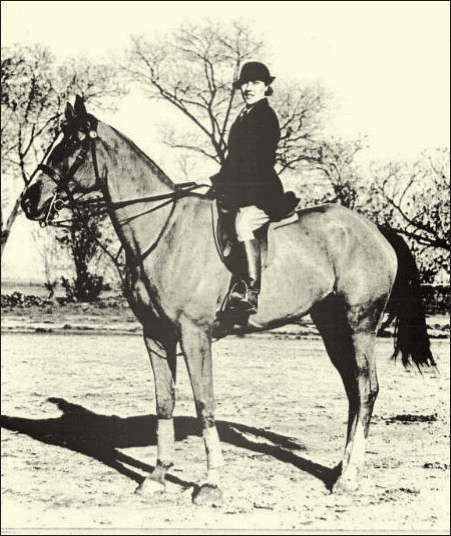 Helen Rousseau on horseback, early 1930s
Helen Rousseau on horseback, early 1930s
Dad thought at first Mother would have a horse, though she had ridden very little. Thought she could come to the stables several times a week, didn't quite understand yet that a painter paints, all day every day. He soon did understand, and that was all right. He and I were off alone.
Mother did ride for a short while, when Dad bought her a young Thoroughbred stallion, a would-be race horse sold cheap because he bucked off all the jockeys, wouldn't let a man on his back.
Crow liked Mother, he was calm and gentle with her. She was excited about having a horse, she bought riding pants, black boots, a black riding coat, all of which we couldn't afford, black hat--while the rest of us, owners and boarders and stable boys, lived in Levi's. Mother and I rode together until one day Dad came home, hugged Mother, said he had sent Crow to Arizona for a few weeks, to breed a herd of quarter horse mares. Crow's blood line was just what was needed, and he would soon be home.
The stallion never came home. He died in Flagstaff, of sleeping sickness, a disease to which the mares, living so long on the desert, had apparently become immune. That was the end of Mother's life on horseback, she was hurt and angry at Dad, hurt thinking of Crow dying so miserably. She returned to painting other horses in their pastures, painting the little farms, sheep and cows and the worlds of boats and fishermen; she refused to own another horse.
I felt bad about Crow, I was angry at Dad, too. But I wasn't disappointed at riding alone. When I grew too big for the little white mare, Dad borrowed a larger pony. When I outgrew him I began to ride the horses Dad trained, pleasure and trail horses, in the nearby shows. Those growing-up years were a blend of pleasures, struck through with a child's painful errors, and with surprising moments.
I was five when the 1933 earthquake hit Long Beach. Dad and I had just come home that evening, were crossing the lawn, Grandmother coming down the steep sidewalk from the big house to have supper with us. Suddenly the whole world shook, she was thrown to the cement, Dad ran, barely caught her. I rose from the grass wondering what had happened. All the neighbors were streaming out their doors.
Neighbors cooked their suppers on the lawn that night, on camp stoves. They slept on the lawn, afraid if they returned to their apartments the walls would collapse on them--everyone slept under the stars except our family, After the quake hit, Mother looked out our front door, saw that no one was badly hurt. Saw that Grandmother was all right, Dad leading her across the lawn, and Mother returned to the kitchen to finish cooking supper.
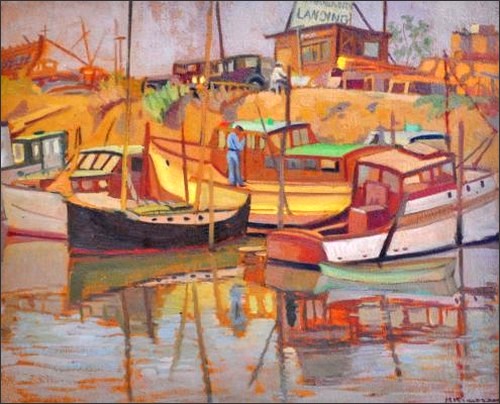 Wagoener Landing (1940)
Wagoener Landing (1940)
The damage across Long Beach was fierce. Two thirds of the big, two story school buildings were destroyed. The newspapers blamed shoddy construction. The quake hit at an hour when school was out, or thousands of children might have died.
The tall brick house Grandfather built so many years ago, the house now half covered with Virginia Creeper, hadn't a crack, not a brick dislodged. None of the apartments were damaged. While the stew simmered, Mother put a few touches to a sailboat painting, and we sat down to supper. She might get upset over little things, the snub of a rude neighbor. But an earthquake was an act of God, there was nothing she could do about it, so why let supper get cold.
If she did any sketches of our neighbors sleeping on the lawn, of little children crying in tents, I don't remember them. The neighbors camped there for a week, waiting for the aftershock. Why didn't Mother paint such a scene?
The second alarm in my life and Mother's was when our new puppy bit me in the stomach and I had to have a rabies shot. Now Mother worried, she worried for weeks. Sport was a mixed-breed gift from my other grandmother, Dad's mother. We were playing with a ball, I held it too close, he leaped for it, and got me.
Neither of us got rabies.
The following years become even more productive for Mother despite my interruptions with childhood illnesses and an occasional accident. Playing with my friend Nancy in the tub, I was the bridge, balancing. Nancy was the steamboat. We were about eight. I slipped, fell, cut my chin badly, went running in the kitchen stark naked, yelling and streaming blood,
There stood the ice man in his uniform, ice box door open, a block of ice over his shoulder. Mother was furious, all the proper training from her mother emerged. She cared not a whit that I was bleeding to death. No matter what had happened, my behavior, naked in front of a stranger, was shockingly improper.
But most days I went with Dad to the stables, we left Mother alone to paint, and that was fine. We would arrive home starved but I always went to the easel first, to see what she had done. Sometimes I liked the work a lot, sometimes I was overwhelmed. Was this the way Mother felt when she started a painting, when she was into a painting? The way she had felt when she was a child, yearning?
About this time, I began to ride in larger, more distant horse shows, getting out of school for a week at a time, staying in nice hotels, competing in classes with grownups--while Mother, at home alone, was a happy hermit. I understood, even then, how valuable was that unbroken time for a painter. Now there were more art exhibits, blue ribbons for Mother, cash awards. While her earlier works had recalled the richness of Otis Oldfield, now her style was loosening further, becoming even more her own. All was well with us, our little family should have felt content.
But somehow the world around us seemed to tense, people ro grow uneasy in their ways. I was only a kid, my mind was on horses; talk of war meant little to me-- until Japan attacked Pearl Harbor, until suddenly we were at war.
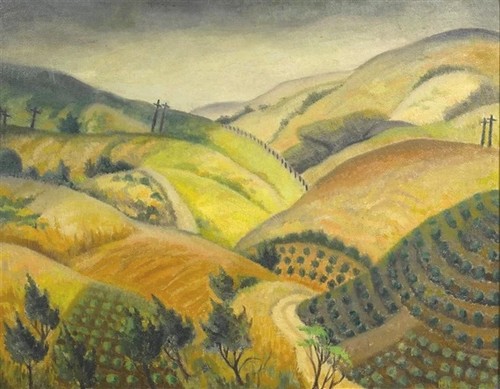 Southern California Cultivation
Southern California Cultivation
Everyone's life changed. Many jobs were not essential, people transferred to those that were. Dad sold many of our horses, sent our boarders back to their owners. There would be no more horse shows until the war was over. Our youngest stable boy was drafted. He soon died in the war, so young. Another stable man joined the Coast Guard. He kept one of our mares at his house, took her by trailer each night to the dark beach where they patrolled until dawn, miles up and down the dark shore carrying spotlights and radio equipment, watching for Japanese landing boats, for the flash of Japanese firearms in the dark.
We had one small Japanese air attack in Long Beach, it seemed to be right over our house. We could hear the planes firing, see fire flashing in the sky, it seemed very low and close to us. Mother and I slept on cushions in the hall, all the doors closed around us, the house totally dark, no lights allowed. We were alone, Dad was away, working for the US Army building roads and landing strips. He had served in WW I, in the Remount, so he wasn't called back to the military.
We had, some years before, moved out of my grandparents' little apartment, had lived in two larger rentals with more studio space, and then had built our own house. That night I lay in the dark hall listening to heavy artillery fire overhead, seeing red flashes under the doors. Wondering if the Japanese would burn down the first house we ever owned--and, more heart wrenching, burn to death Mother's paintings.
But Mother, just as in the earthquake, calmly cooked dinner, got me safely settled in the hall, moved seven of her newest paintings in with us, and came to bed. She could not change the power of the Japanese air force. Could not know where they would hit. So why not get some sleep?
Dad was gone for weeks at a time. I entered my first year of high school. Mother did not paint imagined war moments, as did some artists. She remained close to the sunny, happy scenes of California--places we hoped would still be safe when the war was over,
Other than that one small, nighttime air attack, the war didn't bother most stateside families unless they had children or relatives in the service; then it was a painful time. Mother's little sister Ruth had married a young man who would soon be a bank president in Pasadena. They had two children, they visited us often. Mother's young brother, Melvin, had studied at the Julliard School of Music, he had played first trombone with the Philadelphia Philharmonic but also had gone back to college to get his law degree. He practiced law in Long Beach until we were well into the war--until he was arrested for smuggling pearls out of Japan. Smuggling in collusion with the enemy during World War II, and he was sent to prison.
This distress terribly upset Mother. Melvin was her little brother. Could she have done something to change him, to make this not have happened? For some weeks she didn't paint, was quiet and withdrawn. I got her to take me shopping for school clothes, we even went to a movie. Melvin had deeply hurt Grandmother and Grandfather, the whole family mourned.
 Helen and Otto Rousseau, 1951
Helen and Otto Rousseau, 1951
In New York, Mabel quit teaching, moved out of her apartment, took the train across the continent to Long Beach, to be with her family. She was soon followed by the man she was dating, a Russian Cossack who had escaped his own country during World War I, had flown for the British Air Force, and then come to America to work for Grace Lines. In New York he met Mabel. Now, they were not in Long Beach long when he proposed. They were soon married, a small wedding, and they moved to Ojai, a country village near Santa Barbara, rich with orange groves, orchards, lush vegetable fields. They planted a big garden, planted more fruit trees. Now all the family was within driving distance of one another--all but Melvin.
And all but me. I had enrolled in the California School of Fine Arts, following in Mother's painty footsteps. I would be home only on holidays. Dad was home from driving tractor for the Army, ready to train new colts, new jumpers, to get back in the horse business. He and Mother found a hilly lot in Whittier, to build a house with a larger studio. I longed to return to the horses, to my green, free childhood world. But I had made my choice. I remained in my pokey little boarding house room, with the worst meals I'd ever eaten.
I was in CSFA from 1948 to 1951. During that time, while their house was being finished, Mother and Dad stayed in Tijuana, where Dad had some race horses at Caliente. Mother loved Mexico, the color, the bright little houses, all the activity on the streets. She did some nice work there; then she went on down to San Miguel Allende with a friend, to study with James Pinto. She would write to me about the wonders of Mexico, of her class, of Pinto's work.
And then, the spring I graduated from CSFA, she joined me at her old alma matter, to take a summer course. I stayed in the city, found an apartment for the two of us, and took some summer classes. That was fun, going to school together, batching in a handsome furnished apartment with a real fireplace and a whole wall of books. Mother worked very well with David Park, he was a strong painter whom I had long admired. He and several instructors--Richard Diebenkorn, Elmer Bischoff--had a small jazz group, they played for our occasional school parties; that was where I had met Pat Murphy.
Pat wasn't into the arts, but he had a friend who was, who spent some time at CSFA. Pat was just out of the Marines, welding in the naval shipyard; we dated for three years. During the summer while Mother and I took classes, Pat and a Marine friend drove to Alaska, a rough trip; Pat's car was old; much of the highway was gravel, they had to change a lot of tires. They slept in a tent beside the car hoping the bears were not interested.
That fall when they returned, and summer school was out, Pat and I were married in a small chapel in Berkeley. Dad and some family friends drove up from Whittier. After the wedding, Mother returned with them, to her new house and her huge studio with the broad windows and wide view of the hills. Pat and I lived four years in LA while he attended USC on the GI Bill, then moved to San Bernardino for his first position as a US Probation Officer. During those eight years I painted, did large metal sculpture, and took my work and Mother's to the local shows. Mother was in several group shows during that time, lots of juried exhibits, and was winning awards; she loved her big studio, had no thought to leave Whittier--until Pat was offered a position in the San Francisco Probation Office.
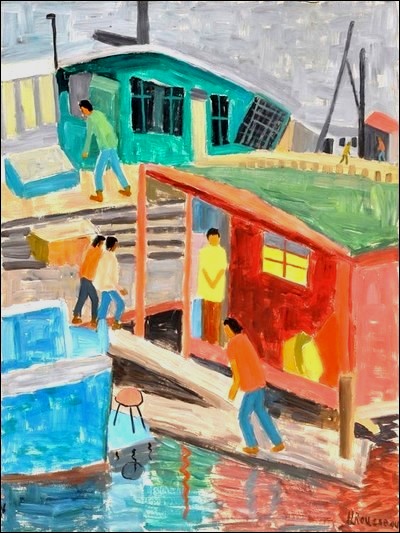 Houseboats
Houseboats
Pat and I jumped at that, we'd had enough of hot desert and vicious winds. Surprisingly, Mother was totally excited when we told her. She missed the Bay Area, she wanted to paint there again. And now, Dad had a new rider who lived just north of the city. Almost at once, mother and Dad decided to move too. This was so perfect. Pat and I sold the San Bernardino house, bought a tiny old house in Mill Valley, among the redwoods. Mother and Dad hated selling their new home; but they found a large house with adequate studio space; and Mother called a friend in Mill Valley, a young man she had known during her summer at art school. Frank Bacher was a print maker, he did small, magical etchings, block prints, lithographs, all the print media. They soon were going sketching together; and later, Frank was to be of great help when Mother was alone in the world.
Now, back in the Bay Area, Mother painted with such delight; she said she felt like a girl again, seeing San Francisco for the first time. She joined the Bay Area art associations, entered every exhibit, she was up early every morning painting or gone sketching. Dad had moved his horses to Novato; Mill Valley was our home now, we were all comfortably settled . . .
When suddenly Pat got a call from the Washington office. They wanted him to move to Central America.
To accept the position of Chief, to establish the only US Probation Office that might ever exist in the Panama Canal Zone, this was an opportunity he could not turn down.
Pat thought it would take about four years to have the government service up and running well. Mother and Dad were happily settled where they wanted to be; so Pat and I made our plans. We would sail out of San Francisco in three weeks on the SS Cristobel, a plain and elderly Canal Company ship. We got our passports, our shots. We had dinner with my folks at our house a week before we would sail. We made an early evening of it, Pat and I were in bed and sound asleep, two in the morning, when the phone rang.
It was the Marin Country Coroner. I thought it was a probation-related call and handed the phone to Pat.
It was for me.
Dad had died half an hour ago.
Mother was at the hospital when we arrived, had ridden there in a police car. She was waiting alone in the lobby sitting quietly, her hands folded in her lap.
 Panama (1964)
Panama (1964)
The next weeks were frantic. Pat made arrangements for Mother to go with us, I couldn't think of leaving her alone. We had a hasty funeral, Dad's family drove up from Central California. Dad's burial on the green San Francisco hills. Phone calls to the US Probation Office in Washington, then to the Panama Canal Company. Another passport. Shots. More packing. Finding safe storage for all our paintings. Both houses back on the market. Our non-glamorous ocean voyage, going through the Panama Canal in the dark of night.
Her time in Central America was a productive period for Mother. Though few juried exhibits existed there, she and and I did have the honor of being the first two North Americans to exhibit, in a two-woman show, at the Instituto Panameno de Arte; and she amassed work to show later in the States. But when, after staying with us in the Canal Zone for a year, she moved into an apartment in Panama, that worried me. She was out sketching every morning on the more colorful, often dangerous Panama streets. Shortly before the date for the show, which was to have television coverage and a champagne opening, the 1964 riots exploded. We could hear the sirens, but Mother stood at her apartment window watching bands of young men burn Panamanian buildings, burn the Panamanian library, haul out stacks of books and throw them on the fire. They had already burned our American flag, burned buildings along the street that divided the two countries. We got her out at three in the morning, in a Panamanian police wagon--and Panama didn't cancel the show, all went as planned, a lovely evening.
Mother soon returned to Mill Valley--on the Cristobel--with a suitcase full of sketches. She left the biggest paintings, of Panama for me to bring later. In Sausalito she rented an apartment, called her friend Frank Bacher, and launched into a new round of sketches and paintings--fishing boats, houseboats, people living their lives at the edge of the bay. Mother never did paint the riots and burning, just as she hadn't painted the earthquake-shattered buildings in Long Beach. She took from the world not dismay, but the bright moments that sang to her as her Mama's memories had sung.
Grandmother died in 1958, in a hospital bed, of heart failure. Grandfather died four years later in his typical style. Dad had taken him to a Utah ranch, deer hunting, a favorite trip they made every year. Grandfather was too weak, now, with leukemia to walk the range as he always had. He sat on the top of a hill as the ranch hands spread out and drove the deer to him.
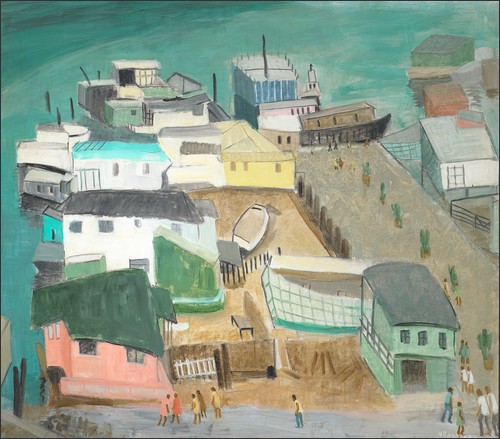 Sausalito Wharf
Sausalito Wharf
Grandfather got a nice buck that evening, had steak for supper, slept well in a ranch-house bunk--and did not wake again.
Mother moved down to Santa Barbara in the early 1970s, where Mabel and her husband Dimitri had re-settled. She painted around the Santa Barbara area, joined the art association and exhibited--but Mabel and Dimitri had taken to bridge and life at the country club. Dimitri died a few years later, of a heart attack. Each sister stayed in her own house. I soon hired a lady to run errands and act as companion for them.
From the icy snow banks of Indiana, from two little girls stealing sled rides, to a world of sun and bright green hills, of crashing waves, brilliant colors and screaming gulls, Helen took what touched her most and made it her own.
*
The twins died within a few years of each other, both of natural causes, in a large house where they lived together with their companion. They are buried side by side in Santa Barbara. Otto Rousseau is buried in the Bay Area hills near where he once owned a speakeasy. Helen's paintings are scattered across the country, each extending a touch of joy to those who have reached for it.
To see a gallery of 80 paintings by Helen Rousseau (full screen width on small mobile devices, a double row on tablets and computers) click on the page titles in the box.
Helen Rousseau by Laura Weir Hill and Scott Hill, from Art of California Magazine, November, 1991
Some of the Paintings
of Helen Rousseau
Paintings: Northern CaliforniaPaintings: Sailboats
Paintings: Living in California
Paintings: Panama and Mexico
Paintings: Southern California
Paintings: 1940s and Earlier
Available paintings by Helen Rousseau
can be seen at
6th Avenue and San Carlos Street
P. O. Box 2953
Carmel-By-The-Sea, CA 93921
phone: (831) 626-1100
email: DMFA@DelMonteFineArt.com
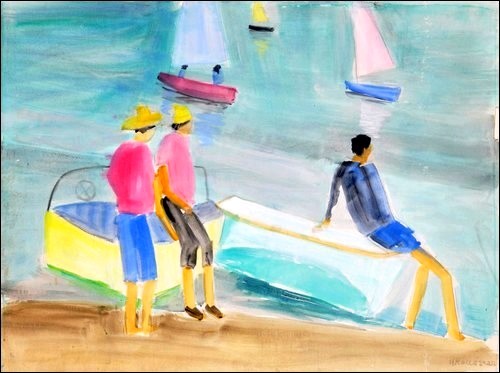
Copyright 2020 by Shirley Rousseau Murphy
Contact: murphy@srmurphy.com